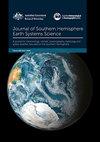Atmospheric rivers associated with summer heavy rainfall over the Yangtze Plain
IF 3.6
4区 地球科学
Q1 Earth and Planetary Sciences
引用次数: 11
Abstract
Atmospheric rivers (ARs) are long, narrow bands of enhanced water vapour transport in the low atmosphere, mainly from the tropics into the midlatitudes. However, it is still unclear how ARs act on different timescales during the boreal summer when frequent heavy precipitation events take place in East Asia, often resulting in severe flood that impacts property and human lives. In this study, we investigated climatological ARs, and their evolution on both synoptic and subseasonal timescales, associated with heavy rainfall events over the Yangtze Plain in China. Furthermore, their predictability was assessed by examining hindcast skills from an operational coupled seasonal forecast system of the Australian Bureau of Meteorology named ACCESS-S1. Results showed that ARs embedded within the South Asian monsoon and Somali cross-equatorial flow provide a favourable background for steady moisture supply of summer rainfall into East Asia. We call this favourable background a ‘climatological East Asian AR’, which has close connections with seasonal cycles and climatological intraseasonal oscillation of rainfall in the Yangtze Plain during its Meiyu season. The East Asian AR was also influenced by anomalous anticyclonic circulations over the tropical West Pacific when heavy rainfall events occurred over the Yangtze Plain. Different from orography-induced precipitation, ARs that led to heavy rainfall over the Yangtze Plain were linked with the intrusions of cold air from the north. The major source of ARs responsible for heavy precipitation events over the Yangtze Plain appeared to originate from the tropical West Pacific on both synoptic and subseasonal timescales. In 23-year hindcasts for May-June-July the current model, ACCESS-S1, had skillful rainfall forecasts at a lead time of 0 month, but the skill degraded significantly with longer lead times. Nevertheless, the model showed skills in predicting the variations of low-level moisture transport affecting the Yangtze River at longer lead time, suggesting that the ARs influencing summer monsoon rainfall in the East Asian region are likely to be more predictable than rainfall itself. There is potential in using AR predictions from the coupled forecast system to guide rainfall forecasts in the East Asian summer season at longer lead time, which can contribute to disaster prevention and reduction in East Asia.大气河流与长江平原夏季强降雨有关
大气河(ARs)是低层大气中水汽输送增强的狭长带,主要从热带向中纬度地区输送。然而,在东亚频繁发生强降水事件的北纬夏季期间,ar在不同时间尺度上的作用尚不清楚,而北纬夏季通常会导致严重的洪水,影响财产和人类生命。本文研究了与长江平原强降雨事件相关的气候ar及其在天气和亚季节时间尺度上的演变。此外,通过检查澳大利亚气象局的一个名为ACCESS-S1的业务耦合季节预报系统的预测技能,评估了它们的可预测性。结果表明,南亚季风和索马里跨赤道气流中的ar为东亚夏季降水的稳定水汽供应提供了有利的背景。我们将这一有利背景称为“东亚气候AR”,它与梅雨季节长江平原降水的季节周期和季节内气候振荡密切相关。当长江平原发生强降水时,热带西太平洋上空的异常反气旋环流也影响了东亚的反气旋。与地形诱导降水不同,导致长江平原强降水的ARs与北方冷空气的入侵有关。在天气和亚季节的时间尺度上,造成长江平原强降水事件的主要ar源似乎来自热带西太平洋。在5月- 6月- 7月的23年预测中,目前的模型ACCESS-S1在提前0个月的时间内进行了熟练的降雨预测,但随着提前时间的延长,技能显著下降。然而,该模式显示出在较长提前时间内预测影响长江的低层水汽输送变化的能力,这表明影响东亚地区夏季季风降雨的ar可能比降雨本身更可预测。利用耦合预报系统的AR预报,有可能在较长的提前期内指导东亚夏季的降雨预报,从而有助于东亚的防灾减灾。
本文章由计算机程序翻译,如有差异,请以英文原文为准。
求助全文
约1分钟内获得全文
求助全文
来源期刊

Journal of Southern Hemisphere Earth Systems Science
Earth and Planetary Sciences-Oceanography
CiteScore
8.10
自引率
8.30%
发文量
0
审稿时长
>12 weeks
期刊介绍:
The Journal of Southern Hemisphere Earth Systems Science (JSHESS) publishes broad areas of research with a distinct emphasis on the Southern Hemisphere. The scope of the Journal encompasses the study of the mean state, variability and change of the atmosphere, oceans, and land surface, including the cryosphere, from hemispheric to regional scales.
general circulation of the atmosphere and oceans,
climate change and variability ,
climate impacts,
climate modelling ,
past change in the climate system including palaeoclimate variability,
atmospheric dynamics,
synoptic meteorology,
mesoscale meteorology and severe weather,
tropical meteorology,
observation systems,
remote sensing of atmospheric, oceanic and land surface processes,
weather, climate and ocean prediction,
atmospheric and oceanic composition and chemistry,
physical oceanography,
air‐sea interactions,
coastal zone processes,
hydrology,
cryosphere‐atmosphere interactions,
land surface‐atmosphere interactions,
space weather, including impacts and mitigation on technology,
ionospheric, magnetospheric, auroral and space physics,
data assimilation applied to the above subject areas .
Authors are encouraged to contact the Editor for specific advice on whether the subject matter of a proposed submission is appropriate for the Journal of Southern Hemisphere Earth Systems Science.
 求助内容:
求助内容: 应助结果提醒方式:
应助结果提醒方式:


